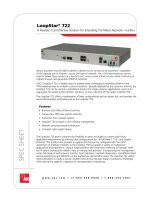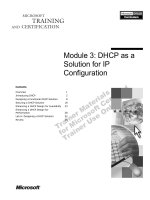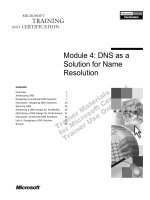Biogas a shitty solution for a problem that stinks
Bạn đang xem bản rút gọn của tài liệu. Xem và tải ngay bản đầy đủ của tài liệu tại đây (700.03 KB, 25 trang )
11/2010 SPERI-FFS 1
Biogas
a shitty solution for a problem that stinks
Writer by: Dave and Joni
Social Policy Ecology Research Institute
Farmer Field School
Topic Workshop - 3/11/2010
Observation Exercise
• Hanoi students break into 2 groups
(new students to Khe Soong)
• Nominate a leader and spokesperson from each group
• Leader collects question paper and group moves to
their observation area to answer questions
• 1 hour – return to Nha So Ba for sharing and
comments at 9:30am
11/2010 2SPERI-FFS
What is biogas?
• A gas that can be burned to give energy.
• Biogas is made by rotting or digesting
manure, food scraps, mulch or anything
that was once living (organic matter).
• The energy that was in the organic matter, is then
stored in the biogas
11/2010 3SPERI-FFS
What is biogas?
• The digestion is done in water, without any air.
• Bacteria and other microbes in the water eat the organic
matter, produce biogas and give nutrients back to the
water.
• This is called anaerobic digestion.
11/2010 4SPERI-FFS
Anaerobic Digestion
Needs:
One or more airtight containers to catch
the gas and to hold water & manure
Bacteria to start the process – fresh
cow/buffalo manure has this naturally
11/2010 5SPERI-FFS
Anaerobic Digestion
Needs:
Temperature is best
between 15 and 40°C
Fairly neutral pH
(not acid, not alkaline)
11/2010 6SPERI-FFS
Inputs:
• Organic matter
– Manure, food scraps
– Garden waste/ mulch
– Hair, cotton, wool
– Anything that was
once living
• Minimal water
Biogas Systems
11/2010 7SPERI-FFS
Outputs:
• Biogas (energy)
– heat / cooking
– light
– Electricity
• Liquid nutrients
• Pressure (energy)
Biogas Systems
11/2010 8SPERI-FFS
Health & Safety
• Fire / explosion
– flames & sparks
– electrical equipment
• Disease
– hygiene, use of nutrients (root crops, low harvest)
• Breathing dangerous gases
– good ventilation around system
11/2010 9SPERI-FFS
Use of products at HEPA
• Cooking with biogas in the
kitchen – much cleaner and
healthier
• Feeding the soil with
liquid nutrients
• Generate electricity?
– Power backup
11/2010 10SPERI-FFS
Design examples
• The following are examples of different design ideas
in many different countries
• Each idea can be built with many different materials
and in various shapes; it is the function and the
principles that are important to apply to our own
design
• Systems thinking diagram of common design
concepts in biogas examples
11/2010 11SPERI-FFS
Design example #1
• Floating gas-holder with weight
• Digestion container has a floating gas-holder
inside that rises & falls with the volume of gas
inside
• Gas-holder has a weight on top to create pressure
11/2010 12SPERI-FFS
Design example #1
11/2010 13SPERI-FFS
Design example #1
11/2010 14SPERI-FFS
Design example #2
• Elastic, expanding gas
storage bag
• Digester is attached to bag /
tube for greater capacity
• Elastic gas storage creates
pressure when stretched
11/2010 15SPERI-FFS
Design example #2
11/2010 16SPERI-FFS
Design example #3
• Small scale system
• Often single-batch
processing only (must
empty & refill) but this can
be changed
• Good for being able to
change the pressure with
water levels
11/2010 17SPERI-FFS
Design example #3
11/2010 18SPERI-FFS
Design example #4
• Fixed volume digester – the
kind we have bought!
• Gas outlet comes directly
from digester, or it can have a
separate solid storage
• Height of inlet/outlet water
levels will change the gas
pressure
11/2010 19SPERI-FFS
Design example #4
11/2010 20SPERI-FFS
Design example #4
11/2010 21SPERI-FFS
Design example #4
11/2010 22SPERI-FFS
This afternoon (chiều nay)
• In the same 2 groups as this morning, we will
rotate between these jobs:
– dig hole for biogas system & empty banana circle
– design exercise at the pig house
• Timing – 2 sessions of 1 ¾ hours each,
then the groups change activity
– 1:30-3:15pm
– 3:15-5:00pm
11/2010 23SPERI-FFS
Design exercise in teams
• Break into 4 groups of about 5 people [mix]
• 2 groups on exercise A and 2 on exercise B
11/2010 24SPERI-FFS
Always think of Design Principles
• Diversity
• Connection
• Feed the Soil
• Natural Succession
• Use the Edge
• Save Energy
• Multiple Functions
• Slow & Small Solutions
• Use Local and Biological Resources
11/2010 25SPERI-FFS









